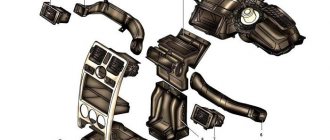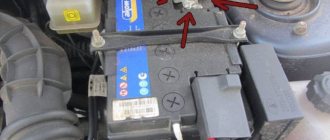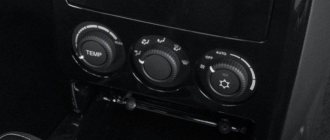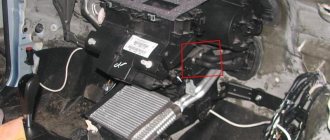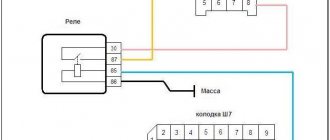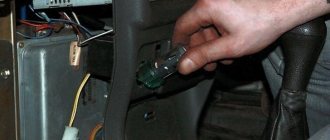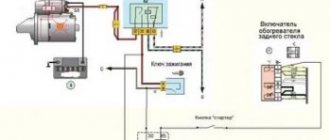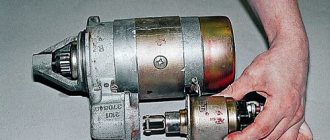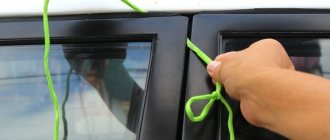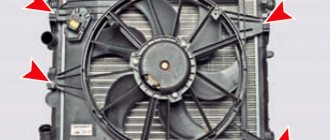How to eliminate stove noise on Lada Priora
The noise of the stove on a Priora is a phenomenon that many owners of this car encounter sooner or later. Moreover, even representatives of the manufacturing plant noted in 2008 that a similar situation is possible on cars with a climate system developed by Panasonic. Service centers were recommended to eliminate inconsistencies in the form of a whistle or hum by installing an additional gasket. However, in situations where the stove on the Priora is noisy, a visit to the service center is not at all necessary.
Optimistic repair option
It’s not worth talking about interfering with the air conditioning and heating systems in the cabin right away. You can get by with less money. At the first appearance of noise, it is necessary to perform the following operations (for configurations with Panasonic air conditioning):
- Turn on the ignition.
- Turn on circulation.
- Turn off the ignition, the throttle will remain in the open position.
- Through the glove compartment, inspect the stove, which could have gotten garbage or any package into it.
If the stove rattles on a Priora with Halla air conditioning, the process occurs a little differently - the stove must be turned off, and the debris must be removed from the impeller after removing the glove box. Please note that the procedure is only possible on cars without a passenger airbag.
Repair with heater disassembly
Another option, due to which the stove fan on a Priora often whistles and makes noise, is a flaw in the design of the heater. For vehicles with Panasonic air conditioning, it is recommended to use an additional seal. It is made from foamed polyethylene (splen). The resulting gasket should have a size of 8x10x100 mm. Installed between the recirculation damper and the heater half-body.
The stove on the Priora also hums in situations where there is play in the axis on which the fan is mounted. To correct this situation, the heater will have to be disassembled - it is necessary to install an additional washer under the fan, which will ensure a tighter fastening of the elements. If this procedure is carried out independently, you must not forget about lubricant for all rubbing parts.
There are situations in which the stove on a Priora hums or whistles only when the interior is warming up, and then the noise disappears. In this case, the solution would be to lubricate the motor rotor bushing. Despite the apparent simplicity of the problem, there are only two options for solving it. The first involves dismantling and disassembling the heater and fan. The second involves removing the frill and then drilling the electric motor with a drill with a diameter of 3 mm. Synthetic oil is poured into the resulting hole using a syringe.
Installing an additional gasket in the heater housing
If the stove fan on a Priora is noisy when the recirculation function is turned off, the reason may be that the damper is rubbing with the fan blades. Therefore, the “whistle” in the Panasonic climate control system is eliminated by installing an additional gasket made of Splen material. The gasket is installed under the recirculation flap, which, as noted above, is accessible from the storage compartment (glove compartment).
The gasket is made from a strip of “Spleen” measuring 8x10x200 millimeters. To make work easier, it is better to remove the glove compartment cover.
In addition to Splen, you will need a good quick-drying glue.
To apply the gasket, you need to feel and move the damper and stick the strip where it touches the heater body. After the glue has dried, the machine can be used.
Removing the stove on a Priora
In a number of situations, when the Priora stove fan is humming, and the simplest operations to clean the impeller do not help, the heater must be removed. This is done according to the following algorithm:
- At the preliminary stage, it is necessary to drain the coolant, move the throttle assembly to the side, remove the frill, and the windshield wiper trapezoid.
- Unclip the harness fasteners from the front heater shield.
- Remove the wiring harness from its mounting to the brake pedal bracket.
- The end of the bracket must be carefully lifted up.
- Having found the radiator pipes, you should loosen the clamps holding them and remove the hoses themselves.
- The wire blocks must be disconnected from the resistor and the electric motor.
- Unscrew the stove mounts using a 10mm socket.
- The top heater mount, which is the last to be unscrewed using a Phillips screwdriver, is a regular self-tapping screw.
- Next, the next block of wires is disconnected - this time from the micromotor-gearbox, for which it is necessary to move the heater forward.
- After the above steps, all that remains is to remove the remaining hoses and remove the housing.
Now you can carry out procedures after which the stove will stop humming and making noise. Please note that the sequence of actions may differ for cars with different types of air conditioners.
If you have experience in removing, disassembling and troubleshooting the Priora stove, do not forget to share your experience in the comments. Other car owners who are faced with the fact that the heater fan on a Priora is noisy would appreciate your advice.
How does airflow work?
The device is very simple - in the cabin, under the panel, there is a heater radiator (possibly an air conditioner nearby), on which a special powerful fan blows. As a rule, it has several blowing modes, usually divided from “1” to “4”; the more you turn on, the stronger the air flow will be. As it becomes clear, in winter the stove radiator is used to heat the interior, in winter the air conditioner radiator is used for cooling.
On new foreign cars it does not make noise (in the first and second positions it is practically inaudible); more precisely, a strong flow of air can be heard, but there are no third-party sounds. This indicates that the fan is working properly and the entire system is working normally.
If you experience a whistling or crackling sound when you turn on the fan, it means that something is wrong here, you need to disassemble the panel and remove the fan. Radiators have nothing to do with it.
Causes of heater failure
There can be a huge number of reasons, but there are several main ones. These include leaks and clogged heater radiators. Let's take a closer look at each.
The radiator is clogged on the outside
When the radiator honeycomb becomes clogged with various debris, its throughput is significantly reduced and it cannot give off heat in the amount necessary for effective heating of the interior.
This happens due to prolonged use of the cabin filter or even neglect of its use.
The radiator is clogged inside
With such a problem, which arises as a result of using low-quality antifreeze or using it for a long time without replacing it, the inside of the radiator becomes clogged. It is for this reason that the coolant does not circulate effectively or does not circulate through the heater radiator at all, which leads to insufficient heating of the heater, thereby complicating the heating of the interior.
Radiator leak
Radiator leaks occur due to many different reasons.
These include:
- Aging;
- Poor quality coolant;
- Corrosion, etc.;
This problem is fraught with the fact that when the radiator leaks profusely, a large amount of coolant is lost, which can lead to engine overheating and, as a result, expensive repairs of the internal combustion engine.
All of the above described causes of radiator malfunction can be eliminated by replacing or flushing it.
Cold heater radiator (heater does not heat)
In driving practice, a common situation is when the Priora’s stove blows cold air instead of hot air.
Let us highlight the main reasons for this situation:
- Failure in the engine cooling system. The stove radiator is cold and does not give off heat. To check, touch the heater pipes, which should be hot. The explanation for the malfunction may be the radiator itself, for example, due to the fact that it is clogged and does not allow antifreeze to pass through.
- Dirty cabin filter. To check the version, dismantle the unit and check whether the stove is functioning or not.
- The gear motor has failed.
- Wedge or damage to the damper.
- Failure of the heating device controller.
- Damage to the temperature sensor installed in the car interior. To check this version, disable it for a while, and then check the operation again.
During long-term operation of the vehicle, dirt collects in the engine block on the pipes, which is subsequently spread throughout the system, thereby clogging the radiator honeycombs. The stove radiator is no exception, which also becomes dirty and begins to work worse.
In such a situation, do the following:
- Drain the antifreeze from the system.
- Remove the wiper arms.
- Remove the frill cover and move the noise shield to the side.
- Disassemble the stove body, discard the wires and remove the electric motor.
- Remove the heat exchanger by discarding the supply pipes.
- Clean or replace it.
Repair, diagnostics and replacement of the heater damper on Lada Priora
A comfortable temperature in the interior of the Lada Priora at low temperatures is maintained using a stove. If it breaks down, noise appears in the heater operation, and the ability to adjust the temperature, direction and intensity of the air flow is lost. In most cases, the sources of problems are the motor or damper of the Lada Priora stove, which fail.
Installing a Priora interior fan
The catalog number of the electric heater fan of the Priora is 2111-8118020. When installing the fan, turn it so that its branch pipe is opposite the motor ventilation hose. The rest of the assembly is done in reverse order.
By the way, if after replacing the heater fan there is poor air flow into the cabin, then try replacing the cabin filter.
Similar materials
Heater device on Priora
The liquid-type heating system on the Lada Priora is structurally connected to the engine cooling system and includes:
- radiator or heat exchanger of the heating system;
- a fan supplying air to the cabin;
- damper that regulates air temperature;
- heater damper reducer;
- damper for flow distribution on deflectors;
- deflectors.
A failed heater damper on a Priora does not close completely, so the warm flow mixes with cold air without warming up to the required temperature and the cabin is always cool and uncomfortable. To fix the problem, you need to remove, replace or repair the heater damper gear motor.
The main differences between a stove with air conditioning and a standard one
The main feature of this device is the presence in the air duct of a heater, an air conditioner evaporator radiator, which cools the air passing through it.
Operating principle of the air conditioner
All cars equipped with these devices have approximately the same set of components. It includes the following elements:
- Control block.
- Relays and fuses.
- Air conditioning radiator with fan.
- Compressor with electric coupling.
- Evaporator.
- Aluminum tubes for connection.
- Sensors and wires.
The main feature of this gas is its ability to lower temperature when strongly compressed. That is, the higher the pressure in the system, the lower the temperature during evaporation. This is such an interesting thing. In general, when turned on, the compressor pumps pressure into the evaporator, located in the heater housing in the path of the air sucked in by the engine. The heated gas goes through the return pipe to the radiator, located in front of the main heat exchanger of the cooling system. And from there, under pressure, again into the evaporator. The air conditioner is turned on from the control panel of the unit, with a button built into the heater mode handle.
Replacing the gearmotor
If the damper does not work, hot or cold air blows from the heater, and the ability to adjust it is lost. In such a situation, the cabin heater gearmotor must be replaced.
Replacing the damper on a Priora begins with raising the hood and removing the wipers. To do this, remove the plastic caps and unscrew the nuts with a 14 wrench, after which they are easily removed. Next, the left and right frills are dismantled by removing the rubber pad, protective plastic caps and unscrewing six screws. Then the plastic soundproofing of the engine compartment is removed, the cooling system hose passing through it is carefully disconnected from the expansion tank, then the tank itself is removed. To avoid draining the coolant, the holes in it must be plugged.
To inspect the heater gear motor, remove the expansion tank mounting bracket by unscrewing two bolts under the wing and removing the protection above the left front wheel. After this, the wiper motor and trapezoid are dismantled.
Now the unit is being dismantled; first you need to carefully disconnect the heater damper sensor and the power supply contacts. After this, install and check the new spare part, reassemble everything in the reverse order, and the replacement of the stove gear motor is completed.
Video: Replacing the gearmotor of the Lada Priora stove (Lada Priora)
How and how to lubricate the stove motor
Currently, manufacturers are trying to make the car as comfortable as possible for humans. To do this, they fill it with convenient and useful functions: heater, heated seats, electric window drives, air conditioning, cruise control, etc.
But the most interesting thing is that the operating principle of all these systems is based on the most basic mechanisms. There are no innovations. As an example, you can take the interior heater or, as drivers call it, the stove. It has been installed in cars since the middle of the last century. Then it was a motor that drove warm air into the pipes and pushed it out into the cabin.
A little later, fans began to be made in plastic cases, with higher power and smaller sizes, in order to reduce size and weight and increase performance. To this day, nothing has changed, only now digital sensors have appeared in the heating, as well as an improved stroke system that allows air to flow into different compartments of the cabin.
Example of a stove motor
Thanks to innovations, the device can independently maintain the desired temperature in the car and heat it effectively. But everything still works from the same motor. He is the heart, which, if it fails, will ruin the entire system. This happens quite often even in imported cars. The main rubbing elements wear out, and the fan begins to hum, creak, or even jam. To prevent this from happening, it is advisable to occasionally service the stove motor and know how to lubricate it.
Table of contents:
Gearmotor repair
In most cases, the extraneous sounds produced by the heater damper drive on a Priora are associated with cracking of the plastic gear. When its teeth are cut off, the mechanism stops working normally. Replacing it is quite difficult, but possible. After dismantling the gearbox, release the compressed plastic cover and bend it, then carefully remove it.
After carefully inspecting the mechanism, determine which gears are faulty and install new ones. Determine the condition of the commutator, bearings and brushes of the mechanism. Lubricate the bearings with silicone grease, which does not harm other structural elements. If after assembly the system functions normally, replacing the heater gear motor will not be necessary.
How to diagnose
The initial microwave check can be considered standard. The device is partially disassembled. To do this, unscrew the screws on the back cover and remove the casing. The insides of the device are carefully inspected. A search is underway for melting zones, parts and contact areas with carbon deposits. The soldering points of the wires and the condition of the latter are inspected very carefully.
Then the main fuse is examined. Its body is transparent. If the fuse works, the broken thread inside will be visible visually. The part needs to be replaced. But if the fuse blows again when turned on, testing continues.
For the further diagnostic process, you will need a tester. All parts on the magnetron board are checked. Dialing can be done without soldering the elements. If units are found with parameters that do not correspond to the circuit diagram, they are replaced. The board testing ends by checking the thermal fuse. In normal condition, its resistance should be zero.
It is not possible to check the power diode with home appliances. It is connected to a 220V network. One end directly to the power wire, the other to the second with the tester connected in series. If the latter shows voltage at one or another position of the diode, it means it is working. Otherwise, the part must be replaced.
The magnetron is tested in several stages.
- Filament. Its resistance is within 10 ohms.
- If the tester shows infinity when checking the filament, it is worth opening the case and checking the reliability of the connection of the terminals and conductors of the inductors.
- The resistance of the body-terminal pairs is checked (for all terminals). If its value is close to infinity, everything is fine. Otherwise, the corresponding feed-through capacitor must be replaced.
If the magnetron passes all tests, but no heating occurs, the part cannot be restored. It has exhausted its service life, the cathode of the lamp is completely depleted and loses emission.
Adjusting the heater damper
Sometimes the reason that the car interior remains cold is that the heater damper does not open, despite the fact that the gear motor is trying to turn it to the desired position. In most cases, the damper regulator, which is responsible for setting it to the desired position, is to blame.
This is possible on the heater dampers both with and without air conditioning due to a clogged cabin filter, which needs to be changed in a timely manner. Dust and leaves prevent the damper mechanism from opening normally.
Another reason is that the thin plastic of the damper simply warps at high temperatures in the heating line, and it stops reaching the desired position. As a result, the stove does not switch to different modes or the flows are distributed unevenly. Most often, the damper regulator remains in the “in the face” position, but the glass does not blow.
If the damper does not switch, you can remove the panel between the driver and passenger seats; it is located directly behind the central heater grilles. Sometimes you just need to change the seal to which it is pressed, or remove debris that has accumulated in it. After this, you need to check the heater damper in operation and you can assemble the panel.
If there are problems with the damper switching mechanism, you need to remove the plastic on the dashboard near the driver’s right foot. If the plastic damper is deformed, it can be replaced, but it is better to do this under warranty. In this case, repair of the stove damper on Priora is limited to treating the mechanism with VD aerosol lubricant. This can be done blindly, without removing the remaining parts of the dashboard, by feeling the switching mechanism with your hand.
After this, the damper is adjusted by simply switching it to different positions and controlling the movement with your hand under the plastic. In the vast majority of cases, this is enough for the stove to work normally again. After this, install the plastic dashboard in place and secure it with self-tapping screws.
Video: Priora stove. Diagnosis of heater malfunction
The stove fan whistles (buzzes or crackles). Can it show up when it’s cold, what to do, how to remove it?
The car's heater is used very often; in winter we heat the interior, but in summer we cool it (cold air from the air conditioner). After a long mileage, and this is usually 80 - 100,000 kilometers, when the air blows, an irritable whistle begins to be heard, probably many have experienced this. After turning off the fan, the whistle disappears. It becomes clear that the stove is whistling, but not the stove itself - but the element for blowing it. What to do, how to fix it, because driving like this is really uncomfortable! There is a way out and in 70% of cases you can do everything yourself...
THE CONTENT OF THE ARTICLE
I would like to note right away that now many people write to me about their specific models, and these are Lada Kalina and many VAZ, Solaris, Ford Focus, Skoda. Guys, today I will not analyze any specific model, all because the disease is treated almost the same. I’ll try to give you some food for thought on how and what to do, and I think you can remove the fan yourself, just go to the forums for your models.
Operating principle of the stove
The heater is controlled by a controller, from which a signal is received to turn on the stove.
The driver sets the temperature in the cabin. If the temperature sensor detects that the temperature has dropped below the set level, the controller sends a signal to change the opening width of the stove damper. In some cases, an electronic failure occurs; instead of hot air, cold air is supplied. The controller also regulates the number of fan revolutions. It sends a signal to an additional resistor, which, in turn, adjusts the operation of the fan using the built-in resistance. The resistor may not be used at all - then the fan runs at maximum speed. Thus, it acts as a “brake” for this node. If the resistor breaks, the fan may not start at all.
The driver can control which direction the air flow will be directed. To do this, he needs to set the value on the dashboard. The control regulators bark a command to move the dampers.
Fixing a problem caused by a broken flap
Sometimes you hear that various debris gets into the car, or more precisely, into the heater, in particular dust and leaves, which clog the heater filter and, therefore, prevent the damper from working properly.
In such a situation, the problem on the Priora can be eliminated by reconstructing the damper switching mechanism. If a motorist does not know where the heater damper is located on a Priora, he can look at the place where the driver’s right foot usually stands. Where the plastic of the torpedo is located, the necessary device is located.
The device you are looking for is a plastic damper, which is made of a fairly thin material, which can become deformed over time of active use under the influence of hot air. If the warranty period for the car has already expired and it is not possible to install a new unit under warranty, the damper can be sprayed with Vedashka. You can understand in what position the device is currently located if you reach the damper regulator on the panel with your right hand, and determine its location under the plastic casing with your left hand. You can process the mechanism blindly, having previously determined the position of the unit. Only first you need to get rid of the section of the casing located next to the gas pedal, attached using several self-tapping screws.
Why can a fan fail?
There are several types of malfunctions of the Priora heater fan. The most common are:
- The heater stopped working completely. In most cases, this is caused by the failure of a 25 A or F 9 fuse. Power is not supplied and the unit does not operate. The second reason may be a malfunction of the heater control unit.
- Noise during fan operation is most often caused by a foreign object getting into it. Most often, dry leaves get stuck between the blades (especially in autumn), this leads to the appearance of extraneous sounds.
- Only mode 4 of the stove works; in all others it does not turn on. This failure can be caused by a faulty resistor or control unit.
Not every car enthusiast can check and repair a complex stove system. If you are not well versed in auto electrics, then you should turn to professionals. Otherwise, you can use the instructions below.
Fan doesn't work
But sometimes another problem occurs with the Priora stove. The driver turns the heater switch, and in response there is silence. The electric motor is not working. What is the reason. There may be several of them:
- The fan motor burned out.
- The heater control unit has failed.
- The fan speed resistor has burned out.
- Broken electrical wiring.
The easiest way to determine if a resistor is broken. In this case, only the maximum speed is turned on, and the stove does not respond to other positions of the handle.
The control unit is checked either by computer diagnostics or by a simple replacement. There are no other options.
The condition of the electric motor can be determined by checking with a test lamp. It is enough to remove the top frill and gain access to the motor connector. Disconnect this connector and insert a test lamp instead of the chip going to the fan. When you turn on the stove handle, the light should light up if the unit and wiring are working properly. If there is no signal, start checking the wires sequentially. If the lamp lights up, replace the electric motor.
Replacing the motor
Although Hallo and Panasonic fan electric motors differ in size and installation point, they have one thing in common. Their location is in a vertical position. This allows you to dismantle them without removing the entire heater. As with a standard heater, the heater fan motor on a Priora with air conditioning is secured with 3 screws.
So, replacement. As in the case of a radiator, first of all you need to open access to the stove. That is, remove the frill and protection. Then disconnect the electrical connector. Now just unscrew the 3 fastening screws and remove the fan with the motor. That's it, you can install a new unit in its place. But this is only for the Hallo heater. With the Panasonic compressor, everything is somewhat more complicated. The fact is that it is also separated from the engine compartment by a plastic casing. According to factory documentation, it is necessary to remove the entire heater to replace the electric motor. And this is draining and refilling freon. But our craftsmen found a way out.
Cut the protection at the narrowest point approximately in the middle of the compartment and remove it by unscrewing 2 fasteners. After this, access to the part being replaced is open. Sometimes, however, in most cases, the engine mount prevents you from pulling out the motor. Don't panic. This problem can be solved by disassembling the motor on site. That is, separate it into 2 halves and pull them out separately. Then insert a new one using the same method.
But still, just in case, before replacement, it is better to consult with car service specialists in advance about possible refilling of the air conditioner with freon in case of damage. This is to replace the motor. But with a radiator, such problems, as a rule, do not happen.
Video on the topic of replacing the radiator of a Priora stove with air conditioning:
